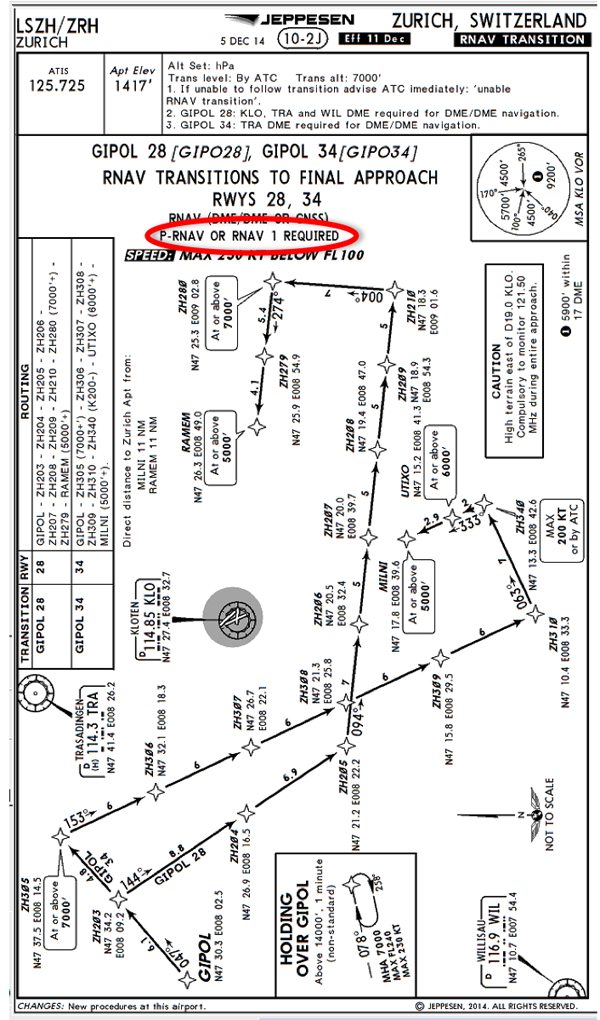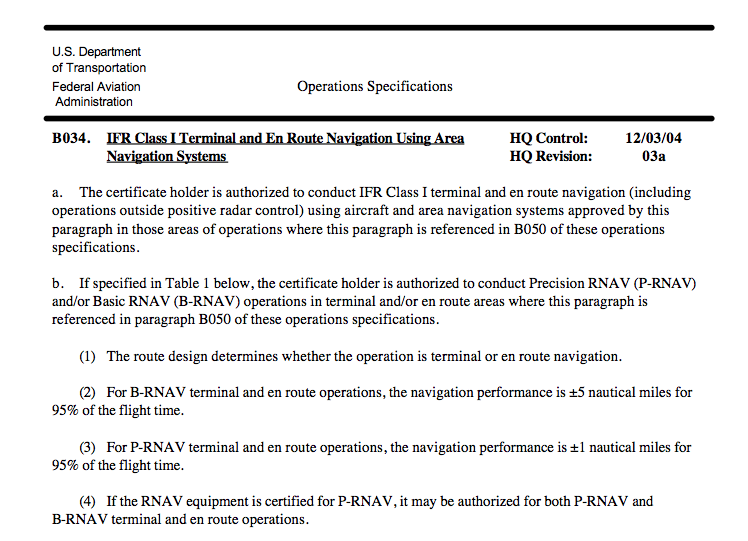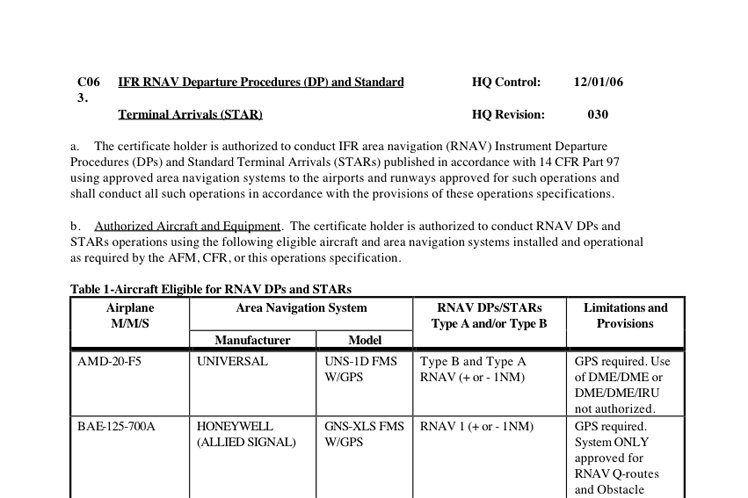There is a lot of confusion about RNAV these days because of its history. RNAV used to mean just about anything that blended navigation signals from various sources and turned that into point-to-point navigation. A LORAN-C, for example, could be considered an early version of RNAV. Then along came various versions of increased accuracy attempts and the first inklings of a 95% of total flight time standard.
— James Albright

Updated:
2019-10-10
Europe's first attempt was B-RNAV and later came P-RNAV. With Performance Based Navigation (PBN) things got much more complicated. The new standard became Required Navigation Monitoring (RNP) which also required performance monitoring and alerting. From that point, it was said, anything that said RNP-XX was performance based and anything that said RNAV-X was equipment based. But RNP-10 is an exception. Waaah??
In an attempt to bring sanity, the U.S. incorporated RNAV-1 and RNAV-2 but didn't change any of their certification rules from B-RNAV and P-RNAV. So we have a problem with trying to figure out what do we need versus what do we have? Let's try to piece together an explanation right now.
Spoiler alert: if you are flying strictly Part 91 (not Subpart K) and have the necessary statements in your manuals, you don't need an LOA.
2 — Accuracy / performance standards

1
Location
In the United States, RNAV-1 and RNAV-2 are meant to apply to terminal and en route navigation and are specified by AC 90-100A, which also lays out the location of the applicable airspace. The figure shows a typical RNAV-1 arrival into Las Vegas.
- This advisory circular (AC) provides operational and airworthiness guidance for operation on U.S. Area Navigation (RNAV) routes, Instrument Departure Procedures (DPs), and Standard Terminal Arrivals (STARs). Operators and pilots should use the guidance in this AC to determine their eligibility for these U.S. RNAV routes and procedures.
- AC 90-100A applies to operation on U.S. Area Navigation (RNAV) routes (Q-routes and T-routes), Departure Procedures (Obstacle Departure Procedures and Standard Instrument Departures), and Standard Terminal Arrivals (STARs).
- This AC sets out a series of performance and functional criteria necessary to conduct RNAV procedures.
Source: AC 90-100A, ¶1
Existing terminal airspace concepts, which include arrival and departure, are supported by RNAV applications. These are currently used in the European (EUR) Region and the United States. The European terminal airspace RNAV application is known as P-RNAV (Precision RNAV). As shown in Volume II, although the RNAV 1 specification shares a common navigation accuracy with P-RNAV, this regional navigation specification does not satisfy the full requirements of the RNAV 1 specification shown in Volume II. As of the publication of this manual, the United States terminal airspace application formerly known as US RNAV Type B has been aligned with the PBN concept and is now called RNAV 1. Basic-RNP 1 has been developed primarily for application in non-radar, low-density terminal airspace. In future, more RNP applications are expected to be developed for both en-route and terminal airspace.
Source: ICAO Doc 9613, ¶2.3.3
The ICAO muddies the water in an attempt to make things clear here. P-RNAV is not exactly the same as RNAV-1 because the RNAV specification encompasses more than just the navigation accuracy standard. The same manual notes a particular state can qualify RNAV-1 as they please, most opting that it must be based on GNSS or DME/DME/IRU or DME/DME. So where does that leave us with P-RNAV over Europe? Read on . . .
In the past, the United States and member States of the European Civil Aviation Conference (ECAC) used regional RNAV specifications with different designators. The ECAC applications (P-RNAV and B-RNAV) will continue to be used only within those States. Over time, ECAC RNAV applications will migrate towards the international navigation specifications of RNAV 1 and RNAV 5. The United States migrated from the USRNAV Types A and B to the RNAV 1 specification in March 2007.
Source: ICAO Doc 9613, ¶1.2.5.5.2
For existing systems, compliance with both P-RNAV (TGL-10) and U.S. RNAV (FAA AC 90-100) assures automatic compliance with this ICAO specification.
Source: ICAO Doc 9613, ¶3.1.2.1
RNAV 1 and RNAV 2 navigation specifications constitute harmonization between European Precision RNAV (P-RNAV) and United States RNAV (US-RNAV) criteria. Aircraft approved for RNAV 1 and RNAV 2 operations are automatically approved to operate within the United States or airspace of the Member States of the European Civil Aviation Conference (ECAC).
Source: ICAO Doc 9613, ¶3.3.1
As the example approach transition shows, some countries are trying to eliminate all doubt by including both the old (P-RNAV) and new (RNAV-1) specifications. ICAO Doc 9613 assures us that having one authorization allows you to use the other.
2
Accuracy / performance standards
b. Area Navigation (RNAV). A method of navigation which permits aircraft operation on any desired flight path within the coverage of station-referenced navigation aids or within the limits of the capability of self-contained aids, or a combination of these. For the purposes of this AC, the specified RNAV accuracy must be met 95% of the flight time.
(1) RNAV 1 requires a total system error of not more than 1 NM for 95% of the total flight time.
(2) RNAV 2 requires a total system error of not more than 2 NM for 95% of the total flight time.
Source: AC 90-100A, ¶4.] Terminology
Operation on U.S. RNAV routes, DPs, and STARs: Does not require the pilot to monitor ground-based NAVAIDs used in position updating unless required by the Airplane Flight Manual (AFM), Pilot Operating Handbook (POH), or the operating manual for their avionics.
Source: AC 90-100A, ¶6.a.(2)
3
Documentation / certification
The Opspec/Mspec/LOA to authorize RNAV-1 and RNAV-2 in the United States is B034, which covers B-RNAV and P-RNAV. The following statement, highlighted, is what gives you that authority. It is convoluted, but that's the way it is. There is an Opspec/Mspec/LOA for commercial operators specifically designed for RNAV 1 and RNP 1, designated C063.
RNAV SYSTEM ELIGIBILITY
- Aircraft with a statement of compliance to this AC in their Aircraft Flight Manual (AFM), Pilot Operating Handbook (POH), or the operating manual for their avionics meet the performance and functional requirements of this AC.
- Aircraft with P-RNAV approval based on GNSS capability meet the functional requirements of this AC. Due to differences in radio navigation infrastructure in the United States, if the approval is based on DME/DME or DME/DME/IRU, the operator should ensure the equipment meets the criteria in appendix 1 or 2, as applicable.
- The following systems meet many of the requirements defined in this AC. Such equipment still requires evaluation by the manufacturer against all the functional and performance requirements in this AC. The RAIM prediction program should comply with the criteria in AC 20-138A, paragraph 12.
- Aircraft with TSO-C129/C129a sensor (Class B or C) and the requirements in a TSO-C115b FMS, installed for IFR use IAW AC 20-130A.
- Aircraft with TSO-C145a sensor, and the requirements in a TSO-C115b FMS, installed for IFR use IAW AC 20-130A or AC 20-138A.
- Aircraft with TSO-C129/C129a Class A1 (without deviating from the functionality described in Appendix 3 of this document) installed for IFR use IAW AC 20-138 or AC 20- 138A.
- Aircraft with TSO-C146a (without deviating from the functionality described in Appendix 3 of this document) installed for IFR use IAW AC 20-138A.
- Aircraft with a statement from the manufacturer documenting compliance with the criteria in this AC (appendix 1 or 2, as applicable, and appendix 3) meet the performance and functional requirements of this AC. These statements should include the airworthiness basis for compliance. Compliance with the sensor requirements in paragraph 8 will have to be determined by the equipment or aircraft manufacturer, while compliance with the functional requirements in Appendix 3 may be determined by the manufacturer or by inspection by the operator.
NOTE: Refer to paragraph 5 for TSO and AC references.
NOTE 1: Aircraft with a demonstrated RNP capability will annunciate when no longer satisfying the performance requirement associated with the operation. However, for DME/DME/IRU-based procedures, the manufacturer still has to determine compliance with appendix 1 or 2 to support evaluation of the DME infrastructure.
NOTE 2: Aircraft with a TSO-C129 GPS sensor and a TSO-C115 or C115a FMS may not meet all of the requirements defined in this AC. Such equipment would require further evaluation by the manufacturer against all the functional and performance requirements in this AC.
Source: AC 90-100A, ¶7
- B034 authorizes an operator to conduct instrument flight rules (IFR) Class I Navigation using an Area Navigation (RNAV) system, as applicable, in the areas authorized in OpSpec/MSpec/LOA B050.
- The RNAV system must meet the en route performance criteria prescribed by the current edition of Advisory Circular (AC) 90-100, U.S. Terminal and En Route Area Navigation (RNAV) Operations.
- B034 also authorizes an operator to conduct IFR operations in designated Basic Area Navigation (B-RNAV)/RNAV 5 and Precision Area Navigation (P-RNAV) airspace.
- For B-RNAV/RNAV 5 terminal and en route operations, the navigation performance is ±5 nautical miles (NM) for 95 percent of the flight time.
- For P-RNAV terminal and en route operations, the navigation performance is ±1 NM for 95 percent of the flight time.
- If the RNAV equipment is certified for P-RNAV, it may be authorized for both P-RNAV and B-RNAV/RNAV 5 terminal and en route operations.
B050 is simply the "Authorized Areas of En Route Operation, Limitations, and Provisions." B034 is not normally so restricted in an LOA. In a commercial operator's Opspecs it usually is and B050 outlines where operations are authorized.
Source: FAA Order 8900, Vol 3, Chap 18, Part B, ¶B034
- The authorization provided by OpSpec/MSpec/LOA C063 is applicable to certificate holders/operators/program managers conducting operations under 14 CFR parts 91K, 121, 125 (including the 125 Letter of Deviation Authority (LODA) A125 holders (125M)), and 135. (For 14 CFR part 129, see Volume 12, Chapter 2, Section 5.)
- OpSpec/MSpec/LOA C063 authorizes certificate holders/operators/program managers to conduct operations using 14 CFR part 97 U.S. instrument flight rules (IFR) terminal Area Navigation 1 (RNAV 1) and/or Required Navigation Performance 1 (RNP 1) departure procedures (DP) and RNAV 1 and/or RNP 1 Standard Terminal Arrival Routes (STAR) in the National Airspace System (NAS). This guidance addresses RNAV 1, RNP 1, and other RNAV flight operations. It also provides guidance authorization for certificate holders/operators/program managers to conduct RNP 1 procedures that include radius to a fix (RF) path terminators and tailored arrivals (TA). Part 91 operators do not need to obtain an LOA for RNAV 1 or RNP 1 approval.
Source: FAA Order 8900, Vol 3, Chap 18, Part C, ¶C063
4
Example compliance
Part 91 operators (excluding subpart K) meeting the RNAV performance requirements in this AC should follow the aircraft and training guidance in this AC, but are not required to obtain a Letter of Authorization (LOA).
Source: AC 90-100A, ¶9.b.
If under 14 CFR 91 you don't need an LOA, why is the FAA willing to issue you an LOA? Because some nations require it, though they should honor to State of Registry's policy that a statement in the AFM is good enough. I think if you are a domestic only operator, you are probably safe without the LOA. But if you do venture overseas, it would be wise to have the LOA. Keep in mind the LOA template still uses the terms P-RNAV and B-RNAV in lieu of RNAV 1 and 2.
Under 14 CFR 135, you will also need OpSpec B034, though you might also need C063.
More about this: Precision Area Navigation (P-RNAV).
References
(Source material)
Advisory Circular 90-100A, U.S. Terminal and En Route Area Navigation (RNAV) Operations, Change 2, 4/14/15, U.S. Department of Transportation
ICAO Doc 9613 - Performance Based Navigation (PBN) Manual, International Civil Aviation Organization, 2008
Jeppesen Airway Manual
_rwy_28_jepp_12-2_16_sep_11.png)




